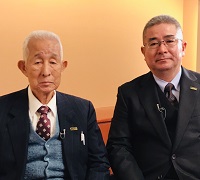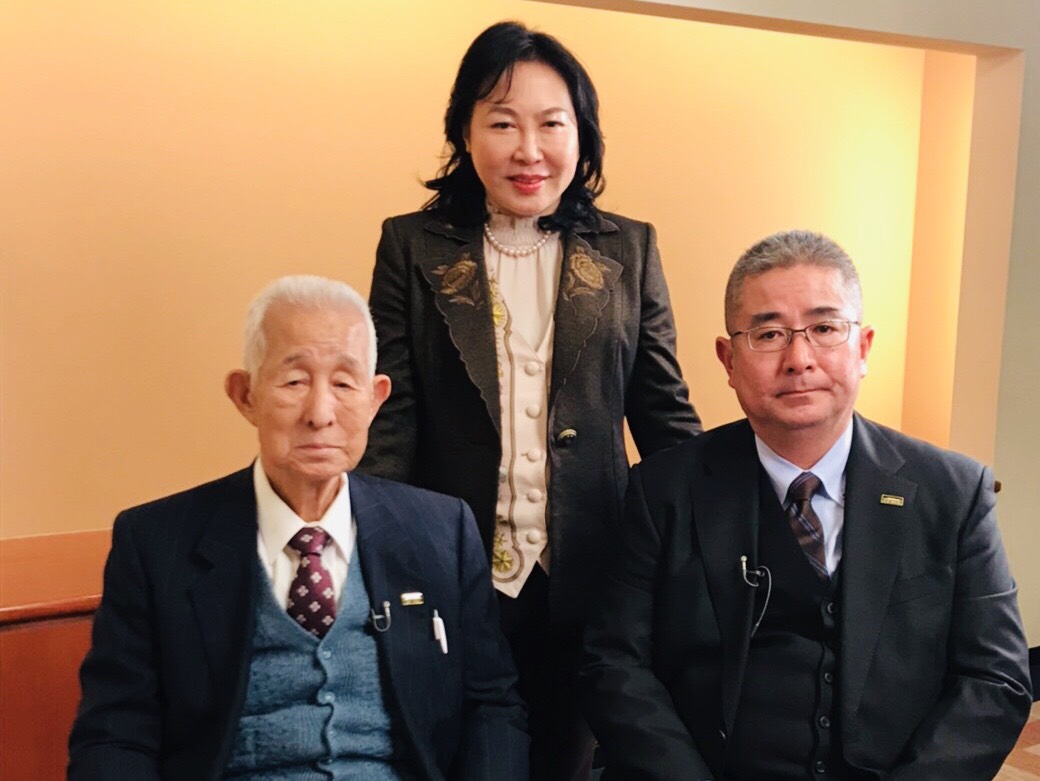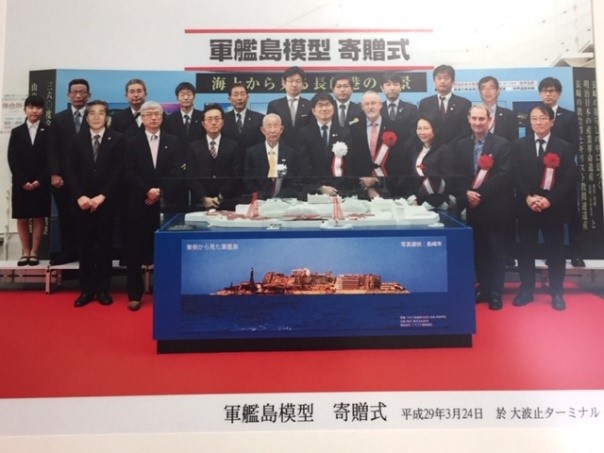PEOPLE
Chairman: Mr. Hidenori Date
President: Mr. Masahiro Date

ーーYou really overcame huge hardships to get to where you are today. Looking back, what do you think the key to survival was?
Mr. Hidenori Date: Looking back I can say I had foresight, but we did really struggle for a long time. However, I knew that trailblazers always face difficulties. Persistence makes perfect, so I kept at it and though trial and error the business evolved. Another factor is that if you continue something long enough, there will come a time when the wind will be at your back. Thinking about it now, meeting Ms. Koko Kato was one of those times.

Mr. Masahiro Date: The first time we saw Ms. Kato was around 1998, I believe. She talked about wanting to inscribe Japan’s industrial heritage sites on the World Heritage List. This was at the idea stage, before it was even called “Sites of Japan’s Meiji Industrial Revolution.” She said the industrial heritage sites would include historic sites and component properties within and outside Nagasaki Port such as Mitsubishi Heavy Industries Nagasaki Shipyard & Machinery Works and Glover Garden, and also Gunkanjima. How great it would be if this actually happened, I thought. But actually I took it as just a pipe dream. It was beyond me how we could get the industrial heritage sites inscribed on the World Heritage List. But before I knew what was happening, she laid out a course of action and made the dream a reality.
Mr. Hidenori Date: There was one other time the wind was at our backs. In 2003, then-prime minister Junichiro Koizumi delivered a speech at Kurogane Bridge in Nagasaki. He said that a new tourism organization called Japan National Tourism Organization (JNTO) would be established, and that Nagasaki has rich tourism resources and should strive to use tourism to recover. After that the director of the Kyushu District Transport Bureau Nagasaki Branch Office took the lead and launched the Local Public Transportation Revitalization Program to give developing tourism resources another try.
Mr. Masahiro Date: In the program tourism development was divided into three areas—the Sasebo - Huis Ten Bosch - Hirado area, the Nagasaki Peninsula area from Nagasaki to Gunkanjima, and the Shimabara Peninsula area. In the Nagasaki area, where our company operated, the plan was to develop a “sea route.” So in July 2004 we developed a new regular service that would depart from Nagasaki, cruise offshore of Gunkanjima, and end in Nomozaki. This gained attention thanks to being covered on the front page of a major newspaper, and in 2006 we reached over 10,000 customers for the year. Then in 2007, then-Nagasaki mayor Iccho Ito had an idea to allow the general public to go ashore and tour Gunkanjima. A plan was formulated and in April 2009 our high-speed sightseeing boat Marbella was the first to offer the service. This really ignited Gunkanjima tourism.
Mr. Hidenori Date: Thanks to everyone’s support, we weathered difficult times, and I’m glad we continued to focus on developing tourism resources. I feel we were rewarded for our efforts.
Masahiro Date: And I was of course happy when the World Heritage Committee decided to inscribe Sites of Japan’s Meiji Industrial Revolution: Iron and Steel, Shipbuilding and Coal Mining in Bonn, Germany in July 2015. Hidenori didn’t accompany me due to his age, but I went with our employees to the public viewing at Glover Garden. I was filled with emotion when I saw Ms. Kato’s face filling the screen—it really hit home that her dream was realized. I remember yelling “Banzai!” with the other employees without caring what anyone else thought [laughs].
Mr. Hidenori Date: We had the good fortune to be able to do business in an area that was at the forefront of Japanese industry, connecting the “Golden Route” by ship—between Nagasaki and the coal mines of remote islands like Hashima and Takashima, and between Nagasaki and Omuta in Fukuoka, which flourished thanks to the Miike Coal Mine. So when I heard the news that it was going to be a World Heritage Site, it made me feel grateful for being blessed with this environment and want to continue passing on the culture of Nagasaki and history of its industrial heritage through the tourism business. And it reaffirmed my desire to expand beyond the shipping business to focus efforts on the development of Nagasaki. I want to express my respect for all the people who were involved in Japan’s industrial revolution and give back to this area—that is our company’s mission.
(Photo) Commemorative photo in front of a 1:250 scale model of Gunkanjima donated by Yamasa Shipping Chairman Hidenori Date (Mayor of Nagasaki is in the front row center, Hidenori Date is to the right, Ms. Koko Kato is to the left, and Yamasa Shipping President Masahiro Date is in the back)

Representative Director, National Congress of Industrial Heritage
(Honorary Advisor, Kyushu Railway Company (JR Kyushu)
Senior Researcher, Industrial Heritage Information Centre
Honorary Advisor, Nippon Mining Co., Ltd.
The Ambassador of Supporting Kamaishi Hometown
Former Director of Nagasaki City World Heritage Office
Former General Manager, Nagasaki Shipyard and Machinery Works, Mitsubishi Heavy Industries, Ltd.
Chairman, Fujisankei Group
Executive Managing Advisor, Fuji Television Network, Inc.
Executive Managing Advisor, Fuji Media Holdings, Inc.
Advisor, Federation of Japan Port and Airport Construction Association
(Ex. Chairman of Specialists Center of Port and Airport Engineering)
Mayor of Nagasaki City
Former Director of the Sano Tsunetami Memorial Museum (currently known as Sano Tsunetami and the Mietsu Naval Dock History Museum)
Director of NPO Association for Thinking about Satoyama
Director of National Congress of the Industrial Heritage
Honorary Chief Priest Toshinari Ueda
Former Mayor of Omuta City
Archaeologist and Heritage Conservation Specialist
A fellow of the Japan Federation of Engineering Societies
Team Member of the Industrial Project Team Office for the Promotion of World Heritage Listing under Cabinet Secretariat
Governor of Kagoshima Prefecture
Mayor of Hagi City
Mayor of Uki City, Kumamoto Prefecture
The Former Employee of Nippon Steel Corporation
An Associate Professor of the Faculty of Science and Engineering in Iwate University
Chairman of the Tourist Guide Association of Misumi West Port
President of Kuraya Narusawa Co., Ltd.
Chairman of Izunokuni City Tourism Association
Director and General Manager of Gunkanjima Concierge
Producer of the Gunkanjima Digital Museum
Owner at Tōge Chaya
Chairman: Mr. Hidenori Date
President: Mr. Masahiro Date
Proprietor, Houraikan Inn
Representative Director of Egawa Bunko non-profit incorporated foundation
The 42nd head of the Egawa Family
Democratic Party for the People (DPP) Representative for Nagasaki Prefecture
President of the NPO, Way to World Heritage Gunkanjima
Representative Director
MI Consulting Group
President of Watanabe Production Group and Honorary Chair of Watanabe Productions Co., Ltd.
Member of the House of Councillors
Governor
Kagoshima Prefecture
World Heritage Consultant
Director and Dean, The Kyushu-Asia Institute of Leadership
Representative Director, SUMIDA, Inc.
Journalist, founder of the Shimomura Mitsuko Ikikata Juku School
Representative, Rally Nippon
Chairman, Sites of Japan’s Meiji Industrial Revolution World Heritage Route Promotion Council Director, National Congress of Industrial Heritage
Representative Director, General Incorporated Foundation National Congress of Industrial Heritage (Advisor, Public Interest Incorporated Foundation Capital Markets Research Institute)
Mayor of Nagasaki City
Policy Director at Heritage Montreal
World Heritage Consultant
Executive Director of Kogakuin University
Heritage Architect and International Consultant
Head of Data Acquisition at The Glasgow School of Art’s School of Simulation and Visualisation
Head of Industrial Heritage, Historic Environment Scotland, Edinburgh
Scottish Ten Project Manager, Historic Environment Scotland, Edinburgh
Mayor of Izunokuni City, Shizuoka Prefecture
Pro-Provost and Chairman of Council of the Royal College of Art. Heritage advisor of Canal & River Trust for England and Wales.
Dean of Tokyo Rissho Junior College
Professor emeritus of Keio University
Mayor of Kitakyushu City
At the 39th session of the World Heritage Committee convened in Bonn, Germany, from June 28 to July 8, 2015, the decision was approved to inscribe the Sites of Japan’s Meiji Industrial Revolution on the World Heritage list.
At a celebratory party held to mark the occasion, some of the primary promoters of the project spoke of their joy in achieving their goal and of the trials and tribulations to getting there.
Director and Managing Executive Officer, Hanshin Expressway Company Limited
Member, Board of Directors, National Congress of Industrial Heritage
Vice-Governor of Shizuoka Prefecture
Mayor of Hagi City
Chairman, Tokyo Metro Co., Ltd.
Mayor of Omuta City
Deputy Director-General, Lifelong Learning Policy Bureau, MEXT
Former Counsellor, Cabinet Secretariat
Mayor of Kamaishi City
Member, Board of Directors, National Congress of Industrial Heritage Counselor, Shimadzu Limited
Chairman of the Consortium for the World Heritage Inscription of Modern Industrial Heritage (Kyushu-Yamaguchi) and governor of Kagoshima Prefecture (as of 2015)